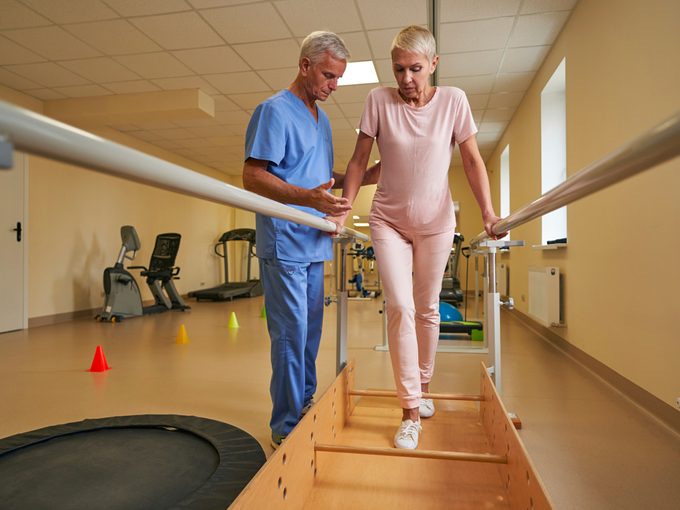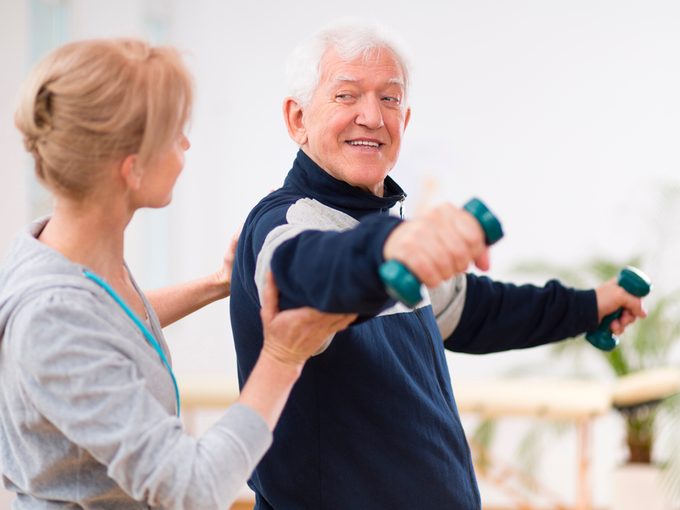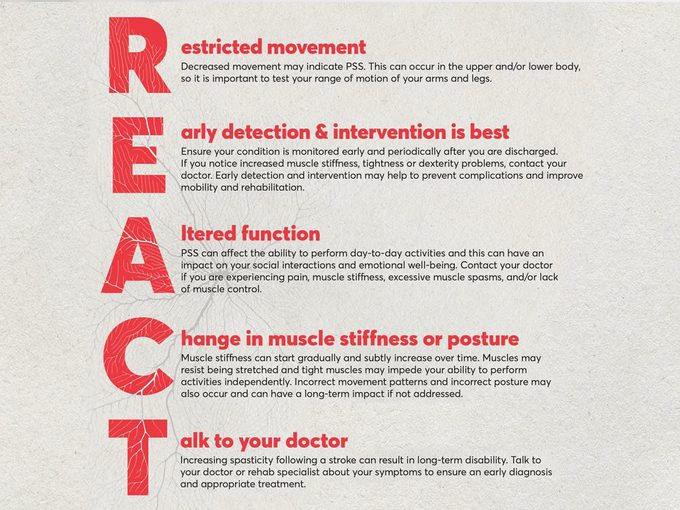Understanding Post-Stroke Spasticity
You may know how to recognize the signs of stroke, but do you know how to REACT?

Stroke happens when blood stops flowing to part of the brain because a blood vessel ruptures or becomes blocked. Some brain cells are deprived of oxygen and nutrients, and die; this can result in brain damage.
While strokes can be fatal, over 80% of those who experience a stroke survive.1 This means that many people are living with the effects of stroke and may need support to recover.
At least 30% of stroke survivors will develop a condition called post-stroke spasticity (PSS).2,3
PSS occurs when muscles become overactive, causing them to contract or become tense when they shouldn’t. It can affect one’s balance, coordination and movement.
Symptoms of PSS may be mild to start but can often worsen over time, which is why early diagnosis, intervention and treatment are crucial. Early symptoms include:
- Painful muscle spasms
- Stiffness in arms, hands, legs and ankles
- Limited mobility
- Limb weakness
- Clenched fist
- Bent elbow
- Curled toes
- Pointed foot

Increasing spasticity can result in long-term disability.
If left untreated, spasticity can lead to abnormal limb posture, soft tissue shortening and shortening of the muscles and tendons, which can ultimately lead to joint contractures — joints being stuck in abnormal, possibly painful positions.2,4
PSS can have physical and emotional impacts, such as pain, pressure sores, risk of falls and fractures, and depression. It can affect quality of life and make getting dressed, bathing, eating and mobility difficult.5,6

Recognize the signs of stroke FAST.
For the best chance of a good recovery from stroke, the Heart and Stroke Foundation of Canada recommends that we learn the signs of stroke and act FAST. If the face, arms or speech is affected, call 9-1-1 right away.
Face—Is it drooping?
Arms—Can you raise both?
Speech—Is it slurred or jumbled?
Time—Time to call 9-1-1 immediately.
After a stroke, remember the acronym REACT to identify spasticity.

R7
E7,8,9,10
A7,9
C7,8
T10,11
While there’s no cure for PSS, the sooner a patient is assessed and optimal treatment is provided, the better the potential outcome.2,3
Physiotherapy and rehabilitation are two effective methods for managing spasticity. They can improve movement in the affected muscles and help promote recovery for increased mobility. Other treatment options include chemodenervation with injections that reduce activity in overactive muscles, skeletal muscle relaxants, electrical stimulations, braces and surgery.

Find resources and support for those living with PSS.
Learn more about stroke and PSS at Heart and Stroke Foundation of Canada. For support, look to the March of Dimes Canada After Stroke Program, a personalized recovery program that helps survivors and their families move forward after a stroke.
Watch this Facebook Live discussion about post-stroke spasticity featuring Dr. Jennifer Yao, Clinical Associate Professor and Head of the UBC Division of Physical Medicine and Rehabilitation.
This article is sponsored by AbbVie Canada.
1 Heart and Stroke Foundation of Canada. (2017). 2017 Stroke Report. Retrieved June 25, 2022, from https://www.heartandstroke.ca/-/media/pdf-files/canada/stroke-report/strokereport2017en.ashx.
2 Wissel, J, Songjin, R. (2021). Assessment, goal setting, and botulinum neurotoxin a therapy in the management of post-stroke spastic movement disorder: Updated perspectives on best practice. Expert Review of Neurotherapeutics. https://doi.org/10.1080/14737175.2021.2021072
3 Gillard PJ et al. (2015). The negative impact of spasticity on the health-related quality of life of stroke survivors: A longitudinal cohort study. Health and Quality of Life Outcomes, 13(159). https://doi.org/10.1186/s12955-015-0340-3
4 Bavikatte, G. et al. (2021, September 20). Early identification, intervention and management of post-stroke spasticity: Expert consensus recommendations. Journal of Central Nervous System Disease, 13: 1-8. https://doi.org/10.1177/11795735211036576
5 Hotter, B. et al. (2018, April 19). Identifying unmet needs in long-term stroke care using in-depth assessment and the Post-Stroke Checklist – The Managing Aftercare for Stroke (MAS-I) study. Eur Stroke J, 3(3): 237-245. https://doi.org/10.1177/2396987318771174
6 Kim, K.T. et al. (2021, December 23). Unmet needs for rehabilitative management in common health-related problems negatively impact the quality of life of community-dwelling stroke survivors. Front. Neurol., 12: 758536. https://doi.org/10.3389/fneur.2021.758536
7 Bethoux, F. (2015, November). Spasticity management after stroke. Phys Med Rehabil Clin N Am, 26(4): 625-639. https://doi.org/10.1016/j.pmr.2015.07.003
8 Glaess-Leistner, S. et al. (2020, November 6). Early clinical predictors of post stroke spasticity. Topics in Stroke Rehabilitation, 28(7): 508-518. https://doi.org/10.1080/10749357.2020.1843845
9 Christofi, G. et al. (2018). Improving the management of post-stroke spasticity: Time for action. Journal of Rehabilitation Medicine, 1(4): 1-7. https://doi.org/10.2340/20030711-1000004
10 Wissel, J. et al. (2020, November 1). Development of an early identification tool in post-stroke spasticity (PSS): The PSS risk classification system. Archives of Physical Medicine and Rehabilitation, 101(11): e35. https://doi.org/10.1016/j.apmr.2020.09.101
11 Thibaut, A. et al. (2013). Spasticity after stroke: Physiology, assessment and treatment. Brain Inj., 27(10):1093-1105. https://doi.org/10.3109/02699052.2013.804202





